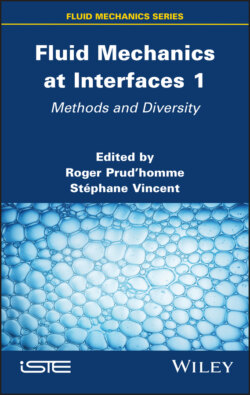Fluid Mechanics at Interfaces 1

Реклама. ООО «ЛитРес», ИНН: 7719571260.
Оглавление
Группа авторов. Fluid Mechanics at Interfaces 1
Table of Contents
List of Tables
List of Illustrations
Guide
Pages
Fluid Mechanics at Interfaces 1. Methods and Diversity
Preface
1. Modeling Interfaces with Fluid Phase
List of symbols
1.1. The concept of an interface
1.1.1. Interface in physics and geometric surfaces
1.1.2. The concept of equilibrium in the domain of interfaces
1.2. Some examples of interfaces. 1.2.1. Fluid phase change and separation interface
1.2.2. Solidification interface
1.2.3. Generalized interfaces
1.3. Mathematical description of an interfacial layer
1.3.1. Normal gradient and tangential gradient
1.3.2. Structure and kinematics of an interfacial layer
1.3.3. Bulk and surface quantities
1.3.4. Interface balances
1.3.5. Constitutive laws
1.4. Some additional information and examples of application
1.4.1. Effective surface tension between two miscible liquids
1.4.2. Terms that come into play in interface balance laws
1.4.3. Normal shockwave
1.4.4. Combustion waves
1.4.5. Thin premixed flame
1.4.6. Boundary layers
1.5. Conclusion
1.6. References
Further references
2. Simulations of Turbulent Two-Phase Flows with Phase Change Using a Multifield Approach Combined with LES1
List of symbols
2.1. Introduction
2.2. Computational model
2.2.1. Two-fluid model
2.2.2. Large Bubble Model
2.2.2.1. Surface tension
2.2.2.2. Drag force
2.2.2.3. Interface sharpening
2.3. Filtered two-fluid equations
2.4. A priori LES study
2.4.1. Presentation of the test case
2.4.2. Order of magnitude of the subgrid terms
2.4.3. Comparison of turbulence models
2.4.4. ADM order
2.4.5. Effect of the filter
2.5. Comparison of turbulence models with true LES
2.5.1. Presentation of the METERO experiment
2.5.2. Presentation of the test case
2.5.3. Simulation results
2.5.4. Comparison between RANS and LES
2.5.5. ADM implementation
2.6. New phase change model for large interfaces
2.6.1. Implementation of the new heat flux model
2.6.2. Validation of the new heat transfer model
2.6.3. Sucking problem
2.6.4. Stefan problem
2.7. Conclusion
2.8. References
3. An Original Approach to Extract Momentum and Heat Transfers from Particle-Resolved Simulations of Particulate Flows
3.1. Introduction
3.2. Numerical methodology
3.2.1. Viscous penalty method
3.2.2. Drag force and heat flux computation using Aslam extension
3.2.2.1. Description of Aslam extension
3.2.2.2. Validation of Aslam extension
3.3. Isolated stationary sphere passed by a uniform flow
3.3.1. Drag force computation
3.3.1.1. Effect of the extrapolation distance δ
3.3.1.2. Pressure coefficient
3.3.1.3. Drag coefficient
3.3.2. Heat transfer computation
3.3.2.1. Effect of the extrapolation distance δ
3.3.2.2. Nusselt number
3.4. Face-centered cubic arrangement of stationary sphere passed by a uniform flow
3.4.1. Monodispersed face-centered cubic periodic arrangement of spheres
3.4.1.1. Drag force
3.4.1.2. Nusselt coefficient
3.4.2. Bidisperse face-centered cubic periodic arrangement of spheres
3.5. Conclusion
3.6. Acknowledgments
3.7. References
4. Interfaces and Critical Fluids
List of symbols
4.1. Thermostatics of fluids in the vicinity of the critical point
4.1.1. Real fluids
4.1.2. A van der Waals fluid
4.1.3. Other laws for gases and dense liquids
4.2. Thermodynamics of fluids in the vicinity of the critical point. 4.2.1. Universal exponents
4.2.2. Isobaric evolutions
4.2.3. Valid expressions of varying distance from the critical point
4.2.4. Summary of theoretical approaches
4.3. A specific mode of heat transmission: the piston effect
4.4. Expansion of a “drop” at critical pressure
4.5. Behavior of a pocket of supercritical fluid immersed into a high-temperature environment
4.6. Boiling near the critical point2
4.7. Conclusion
4.8. References
5. Shear-Induced Anomalies in the Brownian Motion of Particles in Strongly Fluctuating Near-Critical Mixtures
5.1. Introduction
5.2. Theoretical background. 5.2.1. Miscibility critical point in binary mixtures
5.2.2. Effect of shear flow
5.2.3. Colloid Brownian motion and shear flow
5.3. Experiments and methods
5.4. Results and discussion
5.5. Concluding remarks
5.6. Acknowledgements
5.7. Appendix: Light scattering (photon beating spectroscopy)
5.8. References
6. Basics on Interfaces in Combustion
List of symbols
6.1. Introduction
6.2. Non-premixed laminar combustion4. 6.2.1. Overview of a candle flame
6.2.2. Analytical solution of a diffusion flame: the Burke–Schumann problem
6.2.3. Numerical solutions
6.3. Turbulent non-premixed combustion
6.4. Premixed combustion
6.4.1. Propagation of a premixed flame
6.4.2. The combustion rate of the adiabatic, planar premixed flame
6.4.3. Concepts in turbulent premixed combustion
6.5. Plate combustion
6.6. Powders. 6.6.1. Thermites
6.6.2. Solid propellant rockets
6.6.3. Spin-like combustion
6.7. Sprays and fireworks
6.8. Conclusion
6.9. Acknowledgments
6.10. Appendices
6.10.1. Appendix A: The Rankine–Hugoniot theory
6.10.1.1. Reviewing balance equations
6.10.1.1.1. Continuous balance equations
6.10.1.1.2. Discontinuous balance equations
6.10.1.2. A normal stationary shockwave
6.10.1.3. Stationary combustion waves. 6.10.1.3.1. Diagrams
6.10.1.3.2. The results
6.10.2. Appendix B: Historical overview of research on combustion
6.11. References
List of Authors
Index
Summary of Volume 2
WILEY END USER LICENSE AGREEMENT
Отрывок из книги
Edited by
.....
Chapter 5 (D. Beysens) examines shearing that causes Brownian motion anomalies in particles immersed in fluids that are undergoing strong fluctuations close to their critical point.
.....